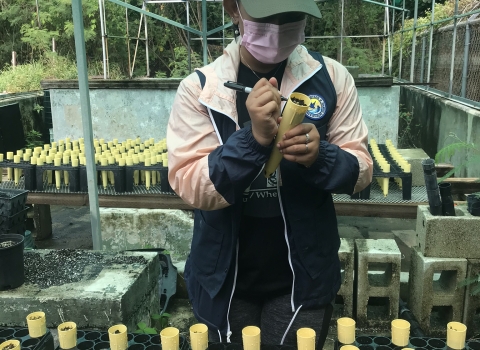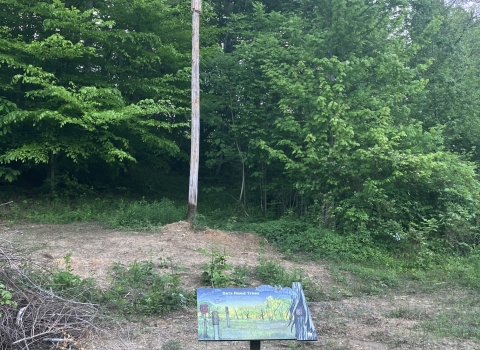Many people head into the mountains to find some peace and quiet. But research from the Peery Wildlife Ecology and Conservation Lab at the University of Wisconsin proves that forests are anything but quiet. A project, now in its third year, is using recording devices placed in California’s national forests to collect millions of hours of forest sounds in the hope of capturing the hoot of a California spotted owl.
In 2023, the U.S. Fish and Wildlife Service proposed to list the California spotted owl as a threatened species in the Sierra Nevada. The owl faces multiple threats, including large, extremely hot wildfires that char the bird’s preferred habitat and nonnative barred owls that outcompete the spotted owl for territory and food. However, more data is needed to determine how quickly these threats are impacting spotted owl populations.
“We’re working with our partners to develop a strategy that will help California spotted owls thrive in the Sierra Nevada, but we need more high-quality science on how the owls use forest habitat, especially as wildfires continue to change the landscape,” said Stephanie Eyes, senior fish and wildlife biologist at the U.S. Fish and Wildlife Service’s Sacramento Field Office.
Kevin Kelly, a program manager working for the Peery Wildlife Ecology and Conservation Lab, is leading a research project partially funded by the Service that aims to answer how the owl uses areas devastated by wildfire and if barred owls are taking over areas once used by spotted owls by listening for hoots.
“Traditional monitoring requires going out into the forest and hooting for the owl. If they hoot back, you know they’re nearby, and you can find them,” said Kelly.
It can be a time-consuming process, so his team is taking a different approach.
Starting in April, Kelly and his team spend a few months traveling the backroads of California’s national forests, stopping every few miles to install a recording device that captures the sounds of the forest. The recording units are placed in burned and un-burned parts of national forests extending from Lassen National Forest to Sequoia National Forest. The team installs about 1,700 recording units and returns about six weeks later to collect them. This method enables researchers to monitor for spotted owls in more locations for longer periods of time.
“The owls are the most vocal from April until June when mating pairs are talking to each other and warning off any neighbors from intruding on their territory. They get quieter later in the summer to avoid drawing attention to chicks in nests,” said Kelly.
Once back at the lab in Wisconsin, the researchers use a computer program to analyze about 1 million hours of sounds collected from the forests. Kelly’s team uses Birdnet, a computer program developed by Cornell University. The program sifts through the recordings using visual depictions of specific sound frequencies. For this study, the program finds and pulls out any sounds that match the vocal signatures of the California spotted owl and barred owl.
“When we positively confirm a hoot from a California spotted owl, we provide that information to U.S. Forest Service biologists so they can log the information and follow-up to confirm owl presence if they need to,” said Kelly.
Preliminary results from the research reveal that the owls are not hooting in areas impacted by high-severity wildfires, even if that was their home territory in previous years. While the owls could be using the area for hunting and foraging, they are not hooting in the open spaces. Doing so could expose them to predators.
These findings align with what Eyes has seen on-the-ground. Eyes spent several years studying wildfire in the Sierra Nevada and monitoring for California spotted owls in Yosemite National Park and nearby national forests. California spotted owls need large trees that create a high canopy with lots of cover. They also like old trees for making nests.
“If a fire removes those elements of a forest, the owls will leave. It’s like if we don’t have a roof over our heads, we won’t stay in our house,” she said.
Kelly aims to continue this research for several years to identify changes in owl locations year-over-year and determine how long the owls stay out of areas impacted by high-severity wildfire. The Service will be working alongside partner organizations to use the information to map the changing habitat in the Sierra Nevada and the owl’s shifting presence in those places.
“These recording devices provide a lot of valuable data. In addition to recording the presence of an owl, the data can tell us how many owls are in the forests and how well the populations are doing. Additionally, there’s the potential for detecting other species that share the forest with the spotted owl,” said Eyes.
Kelly said his team is just starting the process of analyzing data to determine the presence of more than 100 species living in the Sierra Nevada. While the California spotted owl is still the star, they will also look at the range and dispersal of other species, associations between those species, and their responses to wildfire and other habitat changes.
“Ultimately, I hope this research helps people manage public lands in a way that helps the owl populations recover,” said Kelly.



